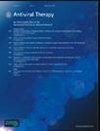JNJ-73763989 pharmacokinetics and safety: Liver-targeted siRNAs against hepatitis B virus, in Japanese and non-Japanese healthy adults, and combined with JNJ-56136379 and a nucleos(t)ide analogue in patients with chronic hepatitis B
IF 2.3
4区 医学
Q4 INFECTIOUS DISEASES
引用次数: 7
Abstract
Background JNJ-73763989 comprises two hepatitis B virus (HBV)-specific, liver-targeted N-galactosamine-conjugated short interfering RNA triggers, JNJ-73763976 and JNJ-73763924. JNJ-73763989 pharmacokinetics, safety and tolerability were assessed in two phase 1 studies: Japanese (NCT04002752), and non-Japanese healthy participants and chronic hepatitis B (CHB) patients also receiving the HBV capsid assembly modulator JNJ-56136379 and a nucleos(t)ide analogue (NA) (NCT03365947). Methods Healthy participant cohorts were double-blind and randomized to receive a single subcutaneous JNJ-73763989 dose (non-Japanese participants, 35, 100, 200, 300 or 400 mg; Japanese participants, 25, 100 or 200 mg) or placebo. JNJ-73763976 and JNJ-73763924 plasma concentrations were assessed over 48 h. CHB patients received JNJ-73763989 200 mg every 4 weeks plus daily oral JNJ-56136379 250 mg and NA in an open-label fashion. Safety and tolerability were assessed through Day 28 (healthy participants) or Day 112 (patients). Results Thirty non-Japanese (n = 4/dose; placebo, n = 10) and 24 Japanese healthy participants (n = 6/dose; placebo, n = 6) were randomized. JNJ-73763976 and JNJ-73763924 exposure generally increased in a dose-proportional manner. Mean plasma half-life was 4–9 h. No differences between pharmacokinetic parameters were apparent between non-Japanese and Japanese healthy participants. In the 12 CHB patients, mean JNJ-73763976, JNJ-73763924 and JNJ-56136379 plasma concentrations 2 h post-dose on Day 29 were 663, 269 and 14,718 ng/mL, respectively. In both studies, all adverse events were mild/moderate. Conclusion JNJ-73763976 and JNJ-73763924 had short plasma half-lives and exposure generally increased in a dose-proportional manner; there were no pharmacokinetic differences between Japanese and non-Japanese healthy adults. JNJ-73763989 with or without JNJ-56136379 and NA was generally safe and well tolerated.JNJ-73763989的药代动力学和安全性:针对乙型肝炎病毒的肝脏靶向sirna,在日本和非日本健康成人中,以及在慢性乙型肝炎患者中与JNJ-56136379和一种核苷类似物联合使用
JNJ-73763989包含两种乙型肝炎病毒(HBV)特异性、肝脏靶向的n -半乳糖胺偶联短干扰RNA触发器,JNJ-73763976和JNJ-73763924。JNJ-73763989的药代动力学、安全性和耐受性在两项1期研究中进行了评估:日本(NCT04002752)、非日本健康参与者和慢性乙型肝炎(CHB)患者也接受了HBV衣壳组装调节剂JNJ-56136379和核苷(t)类似物(NA) (NCT03365947)。方法健康受试者队列采用双盲方法,随机接受单次皮下剂量JNJ-73763989(非日本受试者,35、100、200、300或400 mg;日本参与者,25、100或200毫克)或安慰剂。在48小时内评估JNJ-73763976和JNJ-73763924的血浆浓度。CHB患者每4周接受JNJ-73763989 200毫克,每日口服JNJ-56136379 250毫克和NA,以开放标签的方式。在第28天(健康参与者)或第112天(患者)评估安全性和耐受性。结果30例非日本人(n = 4/剂);安慰剂组,n = 10)和24名日本健康参与者(n = 6/剂量;安慰剂组(n = 6)随机分组。JNJ-73763976和JNJ-73763924的暴露量普遍呈剂量正比增加。平均血浆半衰期为4-9小时。非日本人和日本健康参与者之间的药代动力学参数没有明显差异。在12例CHB患者中,JNJ-73763976、JNJ-73763924和JNJ-56136379在第29天给药后2 h的平均血药浓度分别为663、269和14718 ng/mL。在两项研究中,所有不良事件均为轻度/中度。结论JNJ-73763976和JNJ-73763924血浆半衰期短,暴露量普遍呈剂量正比增加;在日本和非日本健康成人之间没有药代动力学差异。JNJ-73763989联合或不联合JNJ-56136379和NA总体上是安全且耐受性良好的。
本文章由计算机程序翻译,如有差异,请以英文原文为准。
求助全文
约1分钟内获得全文
求助全文
来源期刊

Antiviral Therapy
医学-病毒学
CiteScore
2.60
自引率
8.30%
发文量
35
审稿时长
4-8 weeks
期刊介绍:
Antiviral Therapy (an official publication of the International Society of Antiviral Research) is an international, peer-reviewed journal devoted to publishing articles on the clinical development and use of antiviral agents and vaccines, and the treatment of all viral diseases. Antiviral Therapy is one of the leading journals in virology and infectious diseases.
The journal is comprehensive, and publishes articles concerning all clinical aspects of antiviral therapy. It features editorials, original research papers, specially commissioned review articles, letters and book reviews. The journal is aimed at physicians and specialists interested in clinical and basic research.
 求助内容:
求助内容: 应助结果提醒方式:
应助结果提醒方式:


